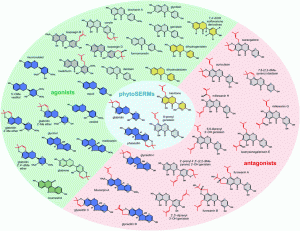Isoflavonoids are a class of secondary metabolites mainly found in Leguminosae (also known as the legume, pea or bean family). Many isoflavanoids can bind the human estrogen receptor so have been termed phytoestrogens. Dietary intake of phytoestrogens has been associated with positive effects on menopausal complaints, hormone-related cancers and osteoporosis. The prenylation of some isoflavonoids results in tissue-specific activity much like selective estrogen receptor modulators (SERMS) and they may have potential in food or pharma applications.
 This review from Jean-Paul Vincken and co-workers in the Netherlands gives, for the first time, a detailed overview of the effect of isofavonoid structural features and the position and extent of their prenylation on thir estrogenic activity, demonstrating that anti-estrogenic and SERM activity of isoflavonoids was always associated with prenylation. Data on dietary occurrence, bioavailability and metabolism of prenylated isoflavonoids is also presented.
This review from Jean-Paul Vincken and co-workers in the Netherlands gives, for the first time, a detailed overview of the effect of isofavonoid structural features and the position and extent of their prenylation on thir estrogenic activity, demonstrating that anti-estrogenic and SERM activity of isoflavonoids was always associated with prenylation. Data on dietary occurrence, bioavailability and metabolism of prenylated isoflavonoids is also presented.
Read the full article for free until 11th July by clicking on the title below:
Prenylated isoflavonoids from plants as selective estrogen receptor modulators (phytoSERMs)
Rudy Simons, Harry Gruppen, Toine F. H. Bovee, Marian A. Verbruggen and Jean-Paul Vincken
Food Funct., 2012, Advance Article, DOI: 10.1039/C2FO10290K
You may also be interested in this Food & Function article which is also free to acces!
The metabolism and analysis of isoflavones and other dietary polyphenols in foods and biological systems
Stephen Barnes, Jeevan Prasain, Tracy D’Alessandro, Ali Arabshahi, Nigel Botting, Mary Ann Lila, George Jackson, Elsa M. Janle and Connie M. Weaver
Food Funct., 2011,2, 235-244, DOI: 10.1039/C1FO10025D
You can keep up to date with the latest developments from Food & Function by signing up for free table of contents alerts and monthly e-newsletters.










